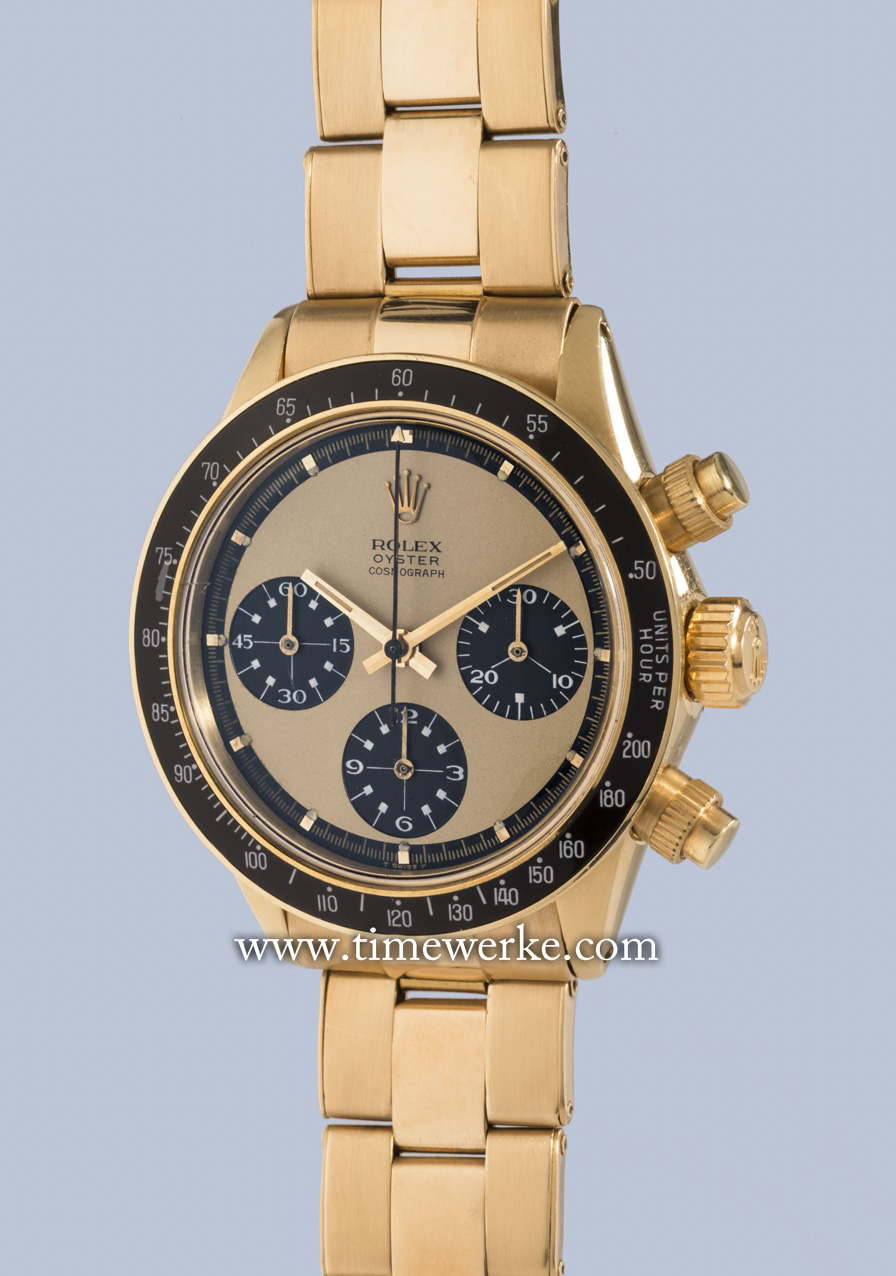
Rolex Gold Oyster Cosmograph “Paul Newman” with case number 2,330,529, also known as “The Legend”. This particular gold variant type is one of only three known. It is actually the third known yellow gold “Paul Newman” with screw-down pushers to appear on the market. This is the rarest variant of the Rolex “Paul Newman” Daytona. It will be offered for auction during the weekend of 13-14 May 2017 and is valued at between CHF800,000 and CHF1.6 million. Photo: © Phillips.
During the weekend of 13 and 14 May 2017, many highly sought-after Rolex watches will be up for auction at The Geneva Watch Auction: FIVE, a double-evening sale held at Hôtel La Réserve and organised by Phillips in Association with Bacs & Russo.
Perhaps the most interesting piece will be the Rolex Reference 6062 “Bao Dai” which is valued at more than US$1.5 million.
Then there is the extremely rare Rolex Reference 6263 “Paul Newman” with a creamy lemon-coloured dial with white subsidiary register graphics made in 1969 and valued at between CHF800,000 and CHF1.6 million.
This particular Rolex Reference 6263 in yellow gold is one of the most important Rolex chronograph wristwatches in the world, highlights Aurel Bacs, senior consultant at Phillips in Association with Bacs & Russo.
What is the significance of this Rolex Gold Oyster “Paul Newman”?
This particular Rolex Oyster Cosmograph “Paul Newman” Reference 6263 with its case back stamped “6239” and with the case number 2,330,529 is also termed “The Legend”. It is regarded the most valuable Rolex Daytona gold variant, notes Phillips.
This very rare and important Rolex Reference 6263 in yellow gold has an early “Paul Newman” dial, screw-down pushers and is the third known model to appear in public. Its Mk 1 “millerighe” pushers are the very ones used for such an early example.
The Rolex Reference 6263 was introduced in 1969. As detailed in auctioneer Phillips’ lot essay, its “… serial number 2,330,529 is among the very earliest to be produced,” adding that the difference in its serial numbering is 127 away from one confirmed example and only 30 from the other.
The Rolex Reference 6263/6239 with the difference of 127 in terms of serial numbering is the one with the case number 2,330,402 and it was sold for CHF841,300 at Antiquorum’s May 2013 auction in Geneva. [References: Antiquorum Catalogue and reported in TimeWerke Volume X, pages 174 and 175 published in 2013.]
Why is the case back stamped “6239” when this is a Reference 6263?
“The case back is stamped 6263 which is correct, as Rolex used the case backs of previous models in the production of the earliest 6263s.
“This feature can also be seen on some of the case backs of ‘Oyster Sottos’,” as noted in the lot description.
The dial of this model has a “creamy lemon shade”, a sharp contrast to the ivory dials of the stainless steel Paul Newman models.
Why are the white subsidiary register graphics significant?
Take a closer look at the subsidiary counters. “The graphics of the subsidiary registers are white which is a clear aesthetic departure from the gilt sub-dials of the Reference 6263 and 6241 Paul Newmans.
“This distinction is incredibly important as it really differentiates the watch from its pump-pusher predecessors.”
With regards to this fine example, what else should one take note of?
“The Rolex Oyster font does not feature any serifs while the Cosmograph signature is slightly serified, signifying the watch is among the earliest batches ever produced.
“It is also important to note that the dial is signed ‘Rolex Oyster Cosmograph’ instead of ‘Rolex Cosmograph Oyster’, a direct reference to the screw-down Oyster pushers.
“In contrast, the Reference 6264 Paul Newman features white graphics but is signed ‘Rolex Cosmograph’. Thus one can conclude that the dial was specially made for the Reference 6263 and Rolex did not simply add an ‘Oyster’ designation to existing Reference 6241 dials,” according to the lot description provided.
It will definitely be an interesting 13-14 May 2017 weekend for hard-core Rolex collectors and enthusiasts.
Another article on timewerke.com that may be of interest is:
i. Rolex Reference 6062 “Bao Dai”: An important piece of history
